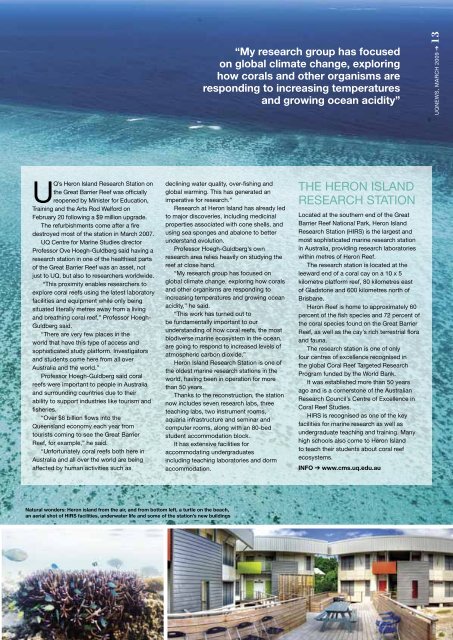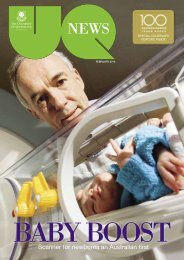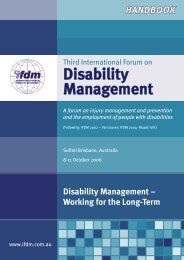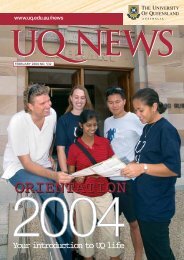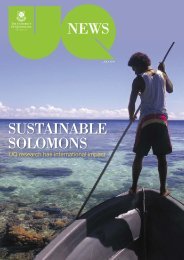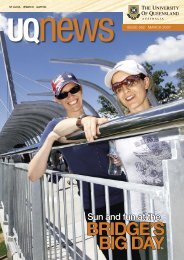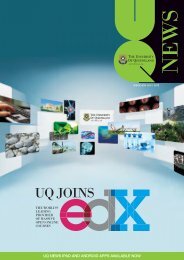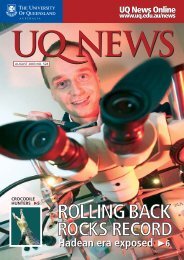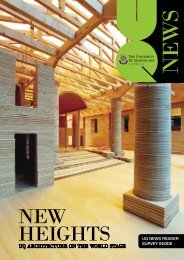Issue 581 (March 2009) - Office of Marketing and Communications
Issue 581 (March 2009) - Office of Marketing and Communications
Issue 581 (March 2009) - Office of Marketing and Communications
- No tags were found...
You also want an ePaper? Increase the reach of your titles
YUMPU automatically turns print PDFs into web optimized ePapers that Google loves.
“My research group has focusedon global climate change, exploringhow corals <strong>and</strong> other organisms areresponding to increasing temperatures<strong>and</strong> growing ocean acidity”UQNEWS, MARCH <strong>2009</strong> ➔ 13UQ’s Heron Isl<strong>and</strong> Research Station onthe Great Barrier Reef was <strong>of</strong>ficiallyreopened by Minister for Education,Training <strong>and</strong> the Arts Rod Welford onFebruary 20 following a $9 million upgrade.The refurbishments come after a firedestroyed most <strong>of</strong> the station in <strong>March</strong> 2007.UQ Centre for Marine Studies directorPr<strong>of</strong>essor Ove Hoegh-Guldberg said having aresearch station in one <strong>of</strong> the healthiest parts<strong>of</strong> the Great Barrier Reef was an asset, notjust to UQ, but also to researchers worldwide.“This proximity enables researchers toexplore coral reefs using the latest laboratoryfacilities <strong>and</strong> equipment while only beingsituated literally metres away from a living<strong>and</strong> breathing coral reef,” Pr<strong>of</strong>essor Hoegh-Guldberg said.“There are very few places in theworld that have this type <strong>of</strong> access <strong>and</strong>sophisticated study platform. Investigators<strong>and</strong> students come here from all overAustralia <strong>and</strong> the world.”Pr<strong>of</strong>essor Hoegh-Guldberg said coralreefs were important to people in Australia<strong>and</strong> surrounding countries due to theirability to support industries like tourism <strong>and</strong>fisheries.“Over $6 billion flows into theQueensl<strong>and</strong> economy each year fromtourists coming to see the Great BarrierReef, for example,” he said.“Unfortunately coral reefs both here inAustralia <strong>and</strong> all over the world are beingaffected by human activities such asdeclining water quality, over-fishing <strong>and</strong>global warming. This has generated animperative for research.”Research at Heron Isl<strong>and</strong> has already ledto major discoveries, including medicinalproperties associated with cone shells, <strong>and</strong>using sea sponges <strong>and</strong> abalone to betterunderst<strong>and</strong> evolution.Pr<strong>of</strong>essor Hoegh-Guldberg’s ownresearch area relies heavily on studying thereef at close h<strong>and</strong>.“My research group has focused onglobal climate change, exploring how corals<strong>and</strong> other organisms are responding toincreasing temperatures <strong>and</strong> growing oceanacidity,” he said.“This work has turned out tobe fundamentally important to ourunderst<strong>and</strong>ing <strong>of</strong> how coral reefs, the mostbiodiverse marine ecosystem in the ocean,are going to respond to increased levels <strong>of</strong>atmospheric carbon dioxide.”Heron Isl<strong>and</strong> Research Station is one <strong>of</strong>the oldest marine research stations in theworld, having been in operation for morethan 50 years.Thanks to the reconstruction, the stationnow includes seven research labs, threeteaching labs, two instrument rooms,aquaria infrastructure <strong>and</strong> seminar <strong>and</strong>computer rooms, along with an 80-bedstudent accommodation block.It has extensive facilities foraccommodating undergraduatesincluding teaching laboratories <strong>and</strong> dormaccommodation.THE HERON ISLANDRESEARCH STATIONLocated at the southern end <strong>of</strong> the GreatBarrier Reef National Park, Heron Isl<strong>and</strong>Research Station (HIRS) is the largest <strong>and</strong>most sophisticated marine research stationin Australia, providing research laboratorieswithin metres <strong>of</strong> Heron Reef.The research station is located at theleeward end <strong>of</strong> a coral cay on a 10 x 5kilometre platform reef, 80 kilometres east<strong>of</strong> Gladstone <strong>and</strong> 600 kilometres north <strong>of</strong>Brisbane.Heron Reef is home to approximately 60percent <strong>of</strong> the fish species <strong>and</strong> 72 percent <strong>of</strong>the coral species found on the Great BarrierReef, as well as the cay’s rich terrestrial flora<strong>and</strong> fauna.The research station is one <strong>of</strong> onlyfour centres <strong>of</strong> excellence recognised inthe global Coral Reef Targeted ResearchProgram funded by the World Bank.It was established more than 50 yearsago <strong>and</strong> is a cornerstone <strong>of</strong> the AustralianResearch Council’s Centre <strong>of</strong> Excellence inCoral Reef Studies.HIRS is recognised as one <strong>of</strong> the keyfacilities for marine research as well asundergraduate teaching <strong>and</strong> training. Manyhigh schools also come to Heron Isl<strong>and</strong>to teach their students about coral reefecosystems.INFO ➔ www.cms.uq.edu.auNatural wonders: Heron isl<strong>and</strong> from the air, <strong>and</strong> from bottom left, a turtle on the beach,an aerial shot <strong>of</strong> HIRS facilities, underwater life <strong>and</strong> some <strong>of</strong> the station’s new buildings


